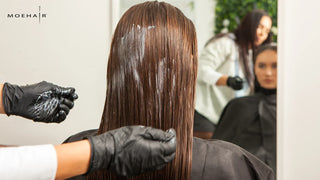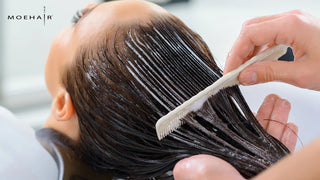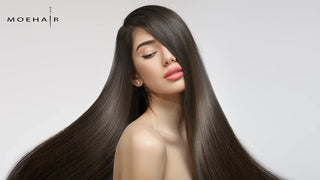 Table of contents
Table of contents
With so many new trends and hairstyles, there’s a good chance of missing out on a hydrating hair care routine. Exposure to the sun, harsh chemicals, and external aggressors often takes a toll on your strands. You might experience dullness and dryness within two to three days of washing your hair. But how do you know if you need a deep conditioning hair treatment? How does it work, and what are the steps? Let’s find out.
What does deep conditioning mean
A deep conditioning treatment pampers your hair more intensely than your regular conditioner. It is your ticket to smooth, soft, and more textured strands. It is usually a thick elixir that coats the tresses and locks in moisture. Deep conditioning hair treatment is nothing but enriching your mane with moisturizing ingredients once in a few days to restore hydration and improve overall vitality.
Before diving into the how-to, let’s understand how deep conditioning differs from your regular rinse-out conditioner. Most hair conditioners are formulated with two active ingredients:
- Emollients are substances that create a protective layer around the strands to prevent external damage and moisture loss.
- Humectants are substances that reverse the drying effect of surfactants present in shampoos. They replenish lost nutrients and hydration.
Deep conditioning products contain higher concentrations of emollients and humectants to restore long-lost hydration. Loaded with oils, water-based ingredients, and hair-boosting vitamins, they help revive hair’s health and smooth frizz.
Why is it important
Deep conditioning is an intensive treatment that improves your hair's moisture level without compromising its texture. But why is it important in the first place? Your hair goes through a lot, including thermal damage from heat styling tools, breakage from harmful chemicals, and dullness caused by environmental aggressors. Gradually, the mane becomes susceptible to frizz and dryness, losing its natural characteristics. Deep conditioning hair treatment works as a restorative therapy against all such concerns and breathes life into your frazzled tresses.
According to London-based Blogger Lesley , deep conditioning is one of those parts of our hair care routine that we shall not compromise on. She believes that regular deep conditioning is one of the critical aspects of keeping chemically treated, relaxed, or dry hair in good condition. Here’s why your hair deserves it at least once in a few days.

Boosts moisture retention
Tired of dry, dull-looking hair? Your parched strands require a deep conditioning treatment to regain the lost moisture and maintain optimal hydration levels. After days of harsh cleansing, brushing, and styling, the mane becomes brittle and requires restorative therapy to cope with damage.
Detangles and smooths frizzy hair
As the deep conditioning product coats your strands, it exhibits a smoothing effect and makes hair less unruly. It helps with detangling and styling. While it eases tough knots, it creates a barrier against environmental aggressors, preserving the enhanced texture for longer. Deep conditioning for frizzy hair is crucial to maintain soft, smooth, and silky tresses.
Improves hair elasticity
Elasticity is one of the indicators of your hair’s health. It tells how much your hair strands can stretch before returning to their original shape. Aggressive brushing and heat styling are responsible for compromised elasticity, leaving hair more prone to breakage. Deep conditioning hair treatment strengthens the shaft, makes hair more flexible, and prevents split ends from reaching the roots.
Promotes scalp health
Most deep conditioners are packed with proteins and other essential nutrients that strengthen the roots and follicles, promoting a healthy scalp. They help rejuvenate the mane from deep within, boosting its overall vitality. They offer much-needed nourishment to create an optimal environment for hair growth, eliminating the signs of aging, dandruff, and infections.
Repairs damaged, processed hair
Adding protein to the hair cuticle, a deep conditioning therapy reverses damage caused by bleaching, coloring, and chemical treatments. It gives your tresses a natural bounce and shine, bringing overprocessed hair back to life. Depending on the formula you choose, it prevents further damage and makes hair more manageable.
How to deep condition hair
It feels awful to see your hair turning lifeless and rough due to a number of factors, including hot tools, the sun, and changing weather conditions. Indulge in deep conditioning hair treatment with these six simple steps and watch your hair transform!
Step 1 - Choose the right deep conditioner
Selecting the right product is crucial in getting the results you want. Here’s a quick guide based on hair type:

- Dry hair - Look for rich, hydrating ingredients like argan oil, shea butter, and coconut oil to deeply moisturize and restore shine.
- Damaged or overprocessed hair - Opt for formulas with keratin, biotin, or protein to strengthen and repair your strands.
- Curly or textured hair - Choose deep conditioners with natural oils and humectants like glycerin to lock in moisture and define curls.
- Color-treated hair - Use color-safe deep conditioners that prevent fading and maintain vibrancy while nourishing your hair.
Step 2 - Wash your hair thoroughly

Start the deep conditioning hair treatment with a clean slate. This helps ensure the conditioner can penetrate your strands effectively. Use a sulfate-free shampoo to cleanse your hair and scalp, removing dirt, excess oil, and product buildup.
Rinse your hair with lukewarm water. Warm water helps open the hair cuticle, allowing the deep conditioner to seep in more effectively. Avoid super hot water, as it can strip your hair of natural oils and cause unnecessary dryness.
Step 3 - Towel dry your hair

After washing, gently squeeze out the excess water from your tresses. Use a microfiber towel or soft cotton T-shirt to pat your hair dry. This step is essential because applying a deep conditioner to soaking wet hair can dilute the product.
Step 4 - Apply the deep conditioner
Here’s where the magic happens! Follow these steps for even application of deep conditioner.

- Section your hair - Divide your strands into 2-4 sections (or more for thicker hair). This ensures every hair strand gets coated evenly.
- Start at the ends - Apply the deep conditioner starting from the mid-lengths to the ends. This is because such areas are more prone to damage. Avoid applying directly to the roots unless your scalp is extremely dry.
- Use a wide-tooth comb - After applying the product, use a wide-tooth comb to distribute it uniformly throughout the mane. This also helps detangle your hair, preventing breakage during rinsing.
Step 5 - Add heat for better absorption

While some deep conditioners work just fine on their own, adding heat can supercharge the process. You can wrap your hair in a shower cap and use a warm towel over it. Always follow the time recommended on the product packaging. As per Mraz Robinson, MD, FAAD, “On average, leave it on for about 20 to 30 minutes.” Leaving the conditioner on for too long can lead to over-conditioning, making your hair heavy or limp.
Step 6 - Rinse off with water

Wash your hair thoroughly with cool or lukewarm water to remove the deep conditioner. The cool water helps seal the hair cuticle, giving your tresses a smooth and shiny finish. Ensure that all product is washed out to avoid residue, which can weigh your hair down.
DIY deep conditioning at home
Regardless of your hair type, a deep conditioning hair treatment once weekly is a must to maintain shine, softness, and texture. Let’s explore some DIY methods to deep condition hair at home.
Tea tree oil
Mix 5 to 7 drops of tea tree oil with a carrier oil of your choice, say coconut or olive oil. Stir the mixture with a spoon. Section your hair strands and apply it to the roots first, gradually moving towards the tips. You can also massage the oil for a few minutes on the scalp to ensure maximum penetration. Wash it within an hour or leave it overnight. Follow up with shampoo.
Coconut oil and ACV mask
Apple cider vinegar and coconut oil offer deep conditioning for frizzy hair, making strands less dry and more manageable. Mix 4 tablespoons (tbsp) of ACV, 2 tbsp of water, and 2 tbsp of coconut oil in a bowl. Stir well and apply the mixture to your clean, damp hair. Keep it on for about 20 minutes, then rinse. Follow up with shampoo and conditioner.Coconut oil and banana mask
Peel a banana and mash it with coconut oil in a blender. Add some honey to the mixture and stir well until a thick consistency is achieved. Apply the obtained mixture to your hair and leave it on for 10 to 20 minutes, depending on hair type. Rinse with cold or lukewarm water.
Egg and olive oil mask
Both being superfoods for your hair, egg and olive oil help retain its original texture and shine. Take one egg and whisk it with 1.5 tbsp of olive oil in a bowl. Apply the mixture to your scalp and hair. Let it work its magic for around 20 minutes. Rinse with cold or lukewarm water. Follow up with a hydrating conditioner if needed.
FAQs
Q1. How often should you deep condition your hair?
According to Deanne Mraz Robinson , MD, once per week is a good rule of thumb for most people, as using it too frequently could lead to product buildup.
Q2. What is the best deep conditioning hair treatment for curly hair?
Choose a lightweight leave-in conditioner for regular conditioning if you have curly or extremely wavy hair. Plus, it is best to use a hydrating hair mask once weekly.
Q3. Should you shampoo after deep conditioning?
In most cases, there is no need to shampoo your hair after deep conditioning. However, DIY masks made with ingredients such as apple cider vinegar may need to be washed out with a sulfate-free shampoo.
Q4. Can you use a deep conditioner overnight?
It may not be necessary to leave the deep conditioner in your hair overnight unless indicated otherwise. Generally, it takes 15-20 minutes for your mane to absorb the product and restore moisture.
Also Read: How to Choose the Best Leave-In Conditioner for Perfect Hair Care Routine
References:
https://freshlengths.blogspot.com/2014/04/hair-how-i-deep-condition.html
https://www.ncbi.nlm.nih.gov/pmc/articles/PMC4387693/
https://www.healthline.com/health/beauty-skin-care/how-to-deep-condition-hair
How we reviewed this article:
Our experts continually monitor the fashion and beauty space, and we update our articles when new information becomes available.
-
Current Version
-
Dec 30, 2024
Written By -
Saloni Sachdeva is a lifestyle writer with 5+ years of experience in writing in the beauty and haircare industry.
Edited By -
Saima Ahmed with 8+ yrs of experience, specializes in crafting engaging content focused on Hair care, lifestyle, and beauty.






















